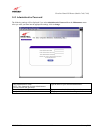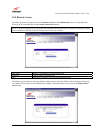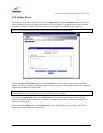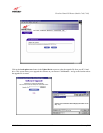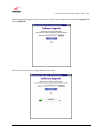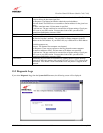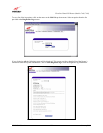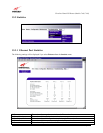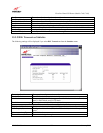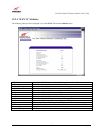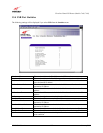
030-300381 Rev. A 118 January 2004
UltraLine Home DSL Router (Models 7400, 7401)
User Guide
If you want to PING using the System Self Test screen (diagnostics page) shown above, enter your DNS or IP
address in the fields provided and click on the test button. The System Self Test will run a diagnostic test that
executes independent of firewall security settings. See the following table for test descriptions and possible
responses.
If you want to PING using the MS-DOS (shell) window, first you will need to check your firewall security setting.
(If you PING via DOS shell you are susceptible to firewall rules, as this PING is dependent on your Router's
firewall settings.) If your firewall is set to Medium or High, you will not be able to PING. You must set your
firewall security setting to Low or None.
Connection/Status
DSL The Router checks the status of the Router connection.
Possible responses are:
UP: The Router is operating correctly and has obtained synchronization with the
opposing network device.
DOWN: The Router is operating correctly, but has not synchronized with the
opposing device.
PPPoE
(Depending on the
connection protocol used:
PPPoE, PPPoA, Bridge,
Classic IPoA)
Indicates that a PPPoE session is or is not established.
Possible responses are:
Session UP: A valid PPPoE session has been detected.
No Session: Currently there is no active PPPoE session established.
Initiating Session: A PPP session must be connected from the homepage screen.
PPP
(Depending on the
connection protocol used:
PPPoE, PPPoA, Bridge,
Classic IPoA)
Indicates that a PPP session must already be established.
Possible responses are:
Connection UP: The Router has established a connection
No Connection: There is no PPP connection
Initiating Connection: The PPP connection process has been initiated
Connection Halted: A successful PPP connection was halted
Cannot Connect: A PPP connection could not be made because of a PPP session
failure.
Authorization Failure: The user name or password is incorrect.
Link Control Protocol Failed: Re-establish the session (from the home page).
Test Description / Test Results
Self Test Performs an integrity check of certain internal components of the Router.
PING ISP’s Router Performs an IP network check (i.e., an IP Ping) of the Service Provider’s Router.
This test verifies that the Router can exchange IP traffic with an entity on the other
side of the DSL line.
Possible responses are:
Success: The Router has detected an IP Remote Router connection.
No Response: The IP Remote Router does not answer the IP Ping.
Could not test: The test could not be executed due to Router settings. Check your
DSL sync or your PPP session. You must have both a DSL sync and a PPP
connection established to execute a PING.
DNS Performs a test to try to resolve the name of a particular host. The host name is
entered in the input box.
Possible responses are:



